#Fleet Air Reconnaissance Squadron 2
Explore tagged Tumblr posts
Text

Two Douglas EA-3B Skywarriors from Fleet Air Reconnaissance Squadron 2 (VQ-2) fly past Gibraltar.
Photographed by PH3 Franklin P. Call, USN., on June 20, 1991.
National Museum of the U.S. Navy: 330-CFD-DN-SC-92-01461
#Douglas A-3 Skywarrior#Douglas A-3#A-3 Skywarrior#A-3#Skywarrior#Douglas#EA-3B#Attack Aircraft#Strategic Bomber#A3D-2Q#Electronic Warfare Aircraft#Aircraft#Fleet Air Reconnaissance Squadron 2#VQ-2#United States Navy#U.S. Navy#US Navy#USN#Navy#Gibraltar#June#1991#my post
43 notes
·
View notes
Text
EA-6B Prowler of VAQ-140 'Patriots' assigned to CVW-3 'AC' aboard CV-67 USS John F. Kennedy in 1986, with other air wing aircraft behind (air wing units listed below)

CVW-3 August 18, 1986 - March 2, 1987 (Mediterranean Sea) aboard USS John F. Kennedy (CV 67)
Fighter Squadron 14 (VF-14) ‘Tophatters’ - F-14A Tomcat
Fighter Squadron 32 (VF-32) ‘Swordsmen’ - F-14A Tomcat
Attack Squadron 66 (VA-66) ‘Waldos’ - A-7E Corsair II
Attack Squadron 75 (VA-75) ‘Sunday Punchers’ - A-6E & KA-6D Intruder
Marine All-Weather Attack Squadron 533 (VMA(AW)-533 ‘Hawks’ - A-6E Intruder
Carrier Airborne Early Warning Squadron 126 (VAW-126) ‘Seahawks’ - E-2C Hawkeye
Tactical Electronic Warfare Squadron 140 (VAQ-140) ‘Patriots’ - EA-6B Prowler
Helicopter Anti-Submarine Squadron 7 (HS-7) ‘Dusty Dogs’ - SH-3H Sea King
Carrier Air Anti-Submarine Squadron 22 (VS-22) ‘Checkmates’ - S-3A Viking
Fleet Air Reconnaissance Squadron 2 (VQ-2) ‘Batmen’ - EA-3B Skywarrior
#ea-6b prowler#prowler#grumman#electronic warfare#us navy#usn#naval aviation#CV-67#uss john f kennedy#aircraft carrier#aviation military pics#military aircraft#military aviation
93 notes
·
View notes
Text
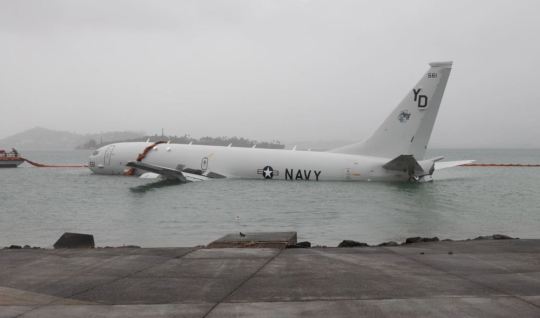
U.S. Navy starts investigation and releases images of the P-8 that sweeped the runway and stopped inside the sea in Hawaii
Fernando Valduga By Fernando Valduga 11/27/2023 - 10:16am Aeronautical Accidents, Military
The U.S. Navy will call an investigation into the November 20 accident in Hawaii, where a Navy's P-8A Poseidon reconnaissance and surveillance aircraft passed the end of the runway and ended up in Kaneohe Bay in Hawaii, authorities said, adding that the aircraft is structurally intact.
Three pilots, along with a crew of two officers and four soldiers, were on board the aircraft at the time, but no injuries were reported, authorities said. The Poseidon belonging to the 4 "Skinny Dragons" Patrol Squadron of Whidbey Island, Washington, was landing at Kaneohe Bay Marine Corps Air Station when, for undetermined reasons, the aircraft left the runway and entered the shallow bay just before 2 p.m. (local time for Hawaii). The weather at the time of the accident was cloudy and windy.
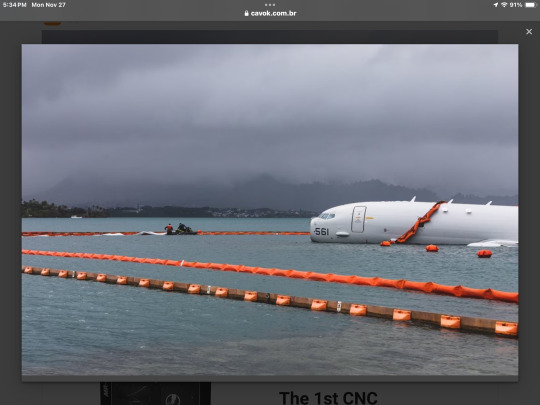
The P-8A Poseidon, based on the Boeing 737 plane, remained in the bay until Tuesday night.
“The U.S. Navy will call an investigation to determine the cause and factors that contributed to the accident,” San Diego-based U.S.-based 3ª Fleet officials said in a statement released Tuesday night.
The flight data recorder has already been recovered while the military continues to plan the removal of the aircraft.
The U.S. Navy Aircraft Accident Council is investigating the site at the Hawaii Marine Corps Base in Kaneohe Bay, trying to determine the cause of the accident and any factors that contributed. A hydrographic survey was carried out to evaluate the structural integrity of the P-8A plane.
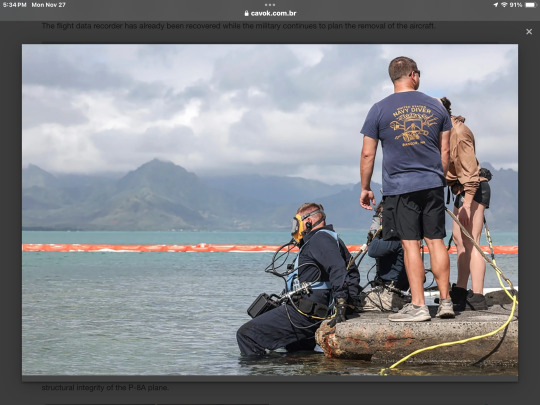
"The preliminary evaluation indicates that the aircraft is structurally intact and there are no signs of fuel leakage from the aircraft," they said. “More information will be released as soon as it is available,” the statement said.
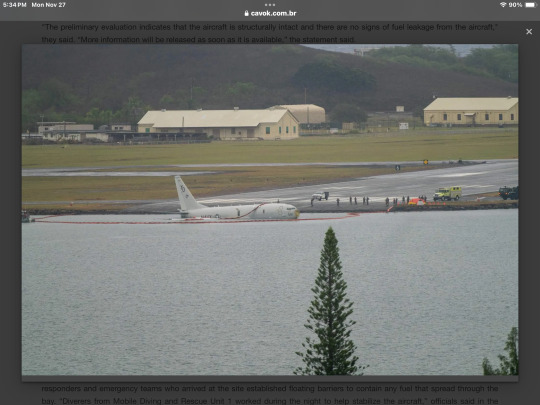
The aircraft ended up near the end of the runway, with its fuselage apparently floating in the sand and coral-covered bay. The first responders and emergency teams who arrived at the site established floating barriers to contain any fuel that spread through the bay. “Diverers from Mobile Diving and Rescue Unit 1 worked during the night to help stabilize the aircraft,” officials said in the statement.
Residents of Kaneohe Bay expressed concerns about possible damage to coral reefs and other potential damage caused by fuels or other chemicals in the area, which is about 2.4 kilometers from a former fishing spot.
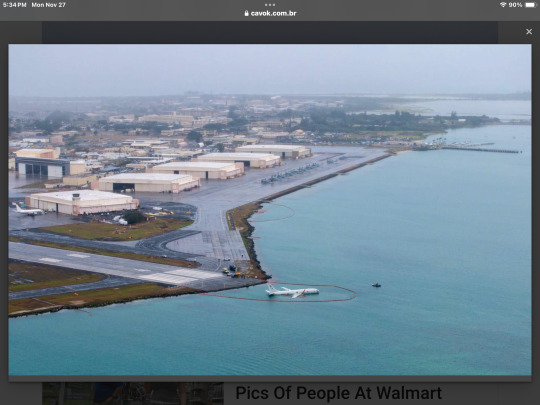
A response team was formed to deal with aircraft recovery, force protection and environmental issues, authorities said. This specially trained team monitors the area 24 hours a day.
Another Washington state crew, from the VP-40 "Fighting Marlins" squadron, arrived Thursday to take over the coverage of the internal defense, the Navy said.
Tags: Aeronautical AccidentsMilitary AviationP-8A PoseidonUSN - United States Navy/U.S. Navy
Sharing
tweet
Fernando Valduga
Fernando Valduga
Aviation photographer and pilot since 1992, has participated in several events and air operations, such as Cruzex, AirVenture, Dayton Airshow and FIDAE. He has work published in specialized aviation magazines in Brazil and abroad. Uses Canon equipment during his photographic work in the world of aviation.
Related news
HISTORY
AIRCRAFT CANCELLED: IML Addax
26/11/2023 - 22:22
MILITARY
Chinese fighters 'orbit' around Philippine Super Tucano aircraft during military exercise
11/26/2023 - 7:00 PM
MILITARY
Twelve things we know about the taxi tests and the first flight of the new B-21
11/26/2023 - 16:34
DEMONSTRATION SQUADS
Frecce Tricolori announces that it will make demonstrations in North America in 2024
26/11/2023 - 12:39
HISTORY
U.S. Navy celebrates 45 years of its first multifunctional aircraft
25/11/2023 - 20:45
ARMAMENTS
MBDA will integrate its missiles into KAI's KF-21 and FA-50 fighters
25/11/2023 - 14:42
7 notes
·
View notes
Video
Spitfire Mk XVI TE311, the latest addition to the Memorial Flight fleet, is a low-back/bubble-canopy Spitfire with ‘clipped’ wingtips. by Mark Mowbray Via Flickr: Spitfire Mk XVI TE311, the latest addition to the Memorial Flight fleet, is a low-back/bubble-canopy Spitfire with ‘clipped’ wingtips.TE311 was built at Castle Bromwich just after the war had ended, being taken on charge by the Air Ministry on 8th June 1945, and delivered to No 39 Maintenance Unit (MU) at Colerne, where it was placed in storage. From October 1945 to February 1946, TE311 was flown by the Handling Squadron of the Empire Central Flying School (ECFS) at Hullavington. It was then stored at No 33 MU at Lyneham until May 1951 when it was allocated to No 1689 Ferry Pilot Training (FPT) Flight at Aston Down. On 21st June 1951, TE311 suffered damage in an accident. Repairs were completed by Vickers Armstrong and the aircraft was returned to 1689 FPT Flight on 31st December 1951. It was subsequently allocated to the Ferry Training Unit at RAF Benson until September 1953 before being returned to 33 MU at Lyneham. In January and February 1954, TE311 served briefly with No 2 Civilian Anti-Aircraft Co-operation Unit at Langham, Norfolk, before being returned to the MU at Lyneham again on 23rd February 1954. On 13th December 1954, TE311 was officially grounded and transferred to non-effective stock. For the next 12 years the aircraft was a ‘gate guardian’ on the main gate at RAF Tangmere. Then, in 1968, TE311 was loaned to Spitfire Productions Ltd, who temporarily modified it with a false rear fuselage to resemble a Mk 1 Spitfire and restored it to taxying condition so that it could be used during filming of ground sequences for the epic film ‘Battle of Britain’. When filming was completed, a RAF working party restored the Spitfire to its original configuration and it was then allocated to the RAF Exhibition Flight. For over 30 years, from 1968 to 1999, TE311 was displayed as a static exhibit at many air shows, regularly being dismantled and re-assembled for transportation by road.In January 2000 TE311 was delivered to RAF Coningsby for ‘spares recovery’ (along with Spitfire Mk XVI TB382, which was broken up for spares and struck off charge). Chief Technician Paul Blackah MBE decided that the aircraft merited a re-build to flying condition. This was started in October 2001, with a small team of engineers initially working on the aircraft in their own time, until official approval was received from the Ministry of Defence in 2007 to return TE311 to flying condition as part of the Flight.After a painstaking re-build lasting 11 years the aircraft was returned to an immaculate and extremely authentic standard, and it took to the air again, for the first time in 58 years, on 19th October 2012. Great credit is due to the Memorial Flight engineers, especially Paul Blackah – the team leader and the driving force behind the project – whose skills and perseverance have resulted in another airworthy Spitfire being added to the limited numbers of these iconic aircraft.TE311 is painted to represent Spitfire Mk XVIe TB675 ‘4D-V’ of No 74 Squadron, the personal aircraft of Squadron Leader AJ ‘Tony’ Reeves DFC, the Squadron’s Commanding Officer from the end of December 1944. No 74 Squadron was part of 145 Wing, 2 TAF.In March 1945, whilst based at Drope, just inside Germany, the Squadron received Spitfire XVIs, which it flew alongside its LFIXs,using them as fighter-bombers on armed-reconnaissance and close air support operations during the advance into Germany. The ground targets attacked by the Spitfires during the last months of the war were numerous and varied. These operations exposed the Spitfires and their pilots to extremely dangerous return fire from the ground – everything from deadly 88mm anti-aircraft guns to small arms fire.
0 notes
Text

11 November 1940:
One of the least known episodes of the Battle of Britain concerns the participation of the ‘Corpo Aereo Italiano’, or ‘CAI’ for shorts.
The Battle was entering its final stages when Mussolini decided to give the Luftwaffe a hand and thus, against Goering’s wishes, the CAI was formed on 10 September 1940. The force consisted of about 200 aircraft: 2 ‘wings’ of Fiat BR.20M medium bombers (13º and 43º Stormo), 1 wing of fighters divided in 2 Gruppos (18º Gruppo equipped with G.50bis and 20º Gruppo equipped with Fiat CR.42s biplanes), and a ‘Squadriglia’ of Cant Z.1007bis for tactical reconnaissance.
During September and October, the Italian units arrived from Italy to their assigned airfields in Belgium, a move that led the Belgian government in exile to declare war on Italy. Operations started on the 24 of November with a night bombing raid on Felixstowe and Harwich, followed by an attack on Ramsgate on the 27, and another on the 29 (considered to be the last ‘official’ day of the Battle of Britain). Other attacks followed during November with the largest one taking place on November 11, curiously the same day in which half the Italian battle fleet was put out of action by the British at Taranto. On that day, 10 BR.20Ms carrying three 250 Kg bombs each, and escorted by 42 CR.42s, 46 G. 50s and supporting Bf 109s were to attack Harwich. Due to bad weather the G.50s and Bf 109s were forced to return to base, leaving only the CR.42s to act as escort for the bombers.
Hurricanes of 17 and 257 squadrons were scrambled to meet the Italians, being later joined by elements of 46 and 249 squadrons. The final tally of the ensuing air battles was 3 BR.20s and 3 CR.42s shot down against 2 Hurricanes damaged. To give an idea of how exacerbated claims usually were during these chaotic clashes, RAF pilots claimed a total of 9 BR.20s destroyed, 1 damaged, and 5 CR.42s destroyed, 4 probable and 3 damaged. In return, the Italians claimed 9 enemy fighters.
One of the 3 Fiat BR.20s actually shot down, and the only Italian bomber (in addition to a few fighters) to ever have crash land on British soil, was the one in this photo, (243-2/MM22621) flown by Sottotenente Pietro Appiani. Pursued by a 46 Squadron’s trio (Leggett, Hedley and Walker), it was damaged and forced to crash land in Tangham Forest, Bromeswell, near Woodbridge, Suffolk.
The radio-operator, 1o Avieri Armando Paolini, had been killed in the air. The co-pilot Sergente Pilota Giuliano Rigolone and the flight engineer, 1o Avieri Motorista Emmanuelle De Gasperi, were wounded (Rigolone later died of his wounds). The pilot Sottotenente Pietro Appiani, De Gasperi, the unit’s photographer Avieri Sc. Mario Pensa, and a sixth crewmember, 1o Avieri Elvino Cerrosi (front air gunner and bombardier), all survived the crash and became POWs.
MM22621 was later removed to the Royal Aircraft Establishment at Farnborough for evaluation, but not before being visited by some British soldiers (judging by the waist size, probably Home Guard), who were more than delighted to find in the wreckage a case containing Italian delicacies and a couple of bottles of wine. No doubt a more then welcome change to their war-time British diet!
(Source - IWM)
(Colorisation by Rui Manuel Candeias)
1 note
·
View note
Text
Top Gun, aircraft identification, and advice for fan-writers and fan-artists.
Heyo, class is in session. This is going to be aimed towards primarily fanfic writers who want to include little details in their fics, and for fan-artists who want to do “accurate” aircraft representation in their works.
We’re going to talk about aircraft identification. Specifically related to the Super Hornet and markings. There are small nuances and details that are easy to overlook, but likely to have any extremely picky aircraft nerd on alert if they’re missed or mis-done.
Class is under the cut.
Let’s take a look at an example aircraft, shall we?

Can you count how many markings are on that aircraft?
If you counted 12-13 (one is on there twice), then award yourself a point. If not, then listen up. We’re going to work from nose to tail here.
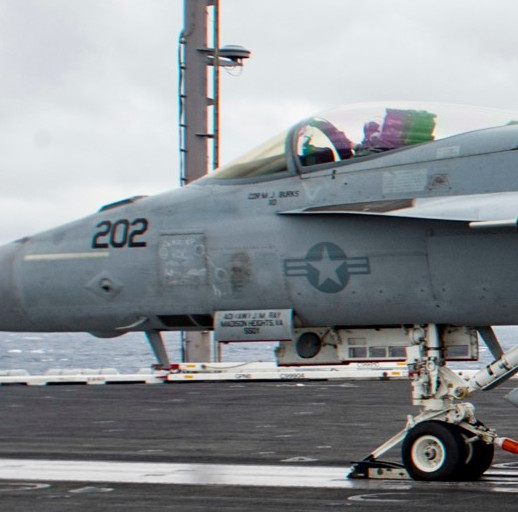
There are four markings here, three of which are what I’d consider “critical” markings if you want to be accurate.
1 - Modex Number. Modex numbers, or simply Modex’s, are used to denote the squadron’s mission and specific aircraft in a squadron. Ripping from Wikipedia here, but the first number of a modex is used to denote mission type, while the last two are the aircraft itself. 1xx through to 4xx are used for Strike Fighter squadrons, typically those that fly F/A-18E/F or F-35C in the Navy and/or Marine Corps. 5xx is for Electronic Attack squadrons, flying the EA-18G Growler. Most squadrons will have twelve aircraft, so you’ll see numbers like 511 and 205 printed on them, but not 566 or 154. Additionally, these numbers are distinctly visible on them, as they are key for identification.
2 - Pilot name. Just below the cockpit is where the name of the pilot (and WSO for F-models) is printed. Typically, it’ll be the abbreviation of the rank, and either the first initial(s) or full first name and surname of the pilot, with their callsign or position below. Here’s a higher resolution example on an F-model Super Hornet. However, a caveat is that pilots don’t exclusively fly “their” jet during their career. It’s subject to whichever aircraft are available that day, depending on sorties and maintenance scheduling.

3 - Roundel. Below the canopy and under the leading edge extension is the roundel, which for the US is that star with the striped ribbon on either side. This is the most important marking on the jet as it allows the aircraft to be visually identified as being operated and owned by the United States of America. 90% of tactical aircraft’s roundels are subdued in nature as not to be immediately overt from a distance, though there are special aircraft liveries where the full colour roundel is displayed.
4 - Crew Chief name. This one isn’t a deal-breaker marking, as it’s something really only seen on the ground and by ground crews. The lead maintainer of the aircraft has their name on the jet, and unlike the pilot, they are the one “responsible” for the aircraft. It’s joked among pilots and ground crews that the jet really belongs to the crew chief, and that the pilot is only borrowing it from them.
That’s the nose covered, now onto the “spine”:
There are three markings here.

1 - Squadron ID code. The squadron identifier is written on the aircraft as another way to identify who the jet belongs to in a pinch. Each letter of that code relates to a designation:
V - Fixed Wing, H for Helicopter/Rotor Wing F - Fighter A - Attack FA - Strike Fighter AQ - Electronic Attack AW - Airborne Warning P - Patrol & Recon Q - Fleet Reconnaissance RC - Logistics Support T - Training X - Air Test & Evaluation
The number simply represents that specific squadron. So, the above example would be Strike Fighter Squadron Eighty-Six. It’s not like how the US Air Force name squadrons, like the 94th Fighter Squadron.
2 - Danger Air Intake marking. It’s partially hidden by the weapon’s pylon, but the air intake does have a warning diamond to indicate the danger from air sucked into the intake. It has happened in the past where deck crew have wandered too close to an aircraft’s intake and get sucked in. Again, these are low-vis subdued, but these were traditionally painted bright RED.
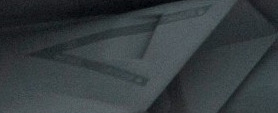
3 - On the front of the fuel drop tank, some squadrons embellish their tanks with squadron-specific markings. Not all squadrons do this, but some do. Some go small like the snake seen in the main image, while others go more bold. Again, not a major deal breaker: research the squadron and you’ll see if they do it on their drops or not.

And now onto the tail and rear. We’ll work top to bottom here:

1 - Modex. We covered this on the nose section, so we’ll move on.
2 - Squadron Marking. Alongside the identifier on the spine, all aircraft will have “artwork” that denotes their squadron, and it’s typically pulled from the squadron’s insignia patch. This is where you have a lot of variation, as some squadrons are low-key in their marking type while others are a lot more flashy, even if they are subdued in colour. Some squadron’s tail markings are very distinct and have the accompanying notoriety. Above is a sidewinder snake, for the eponymous VFA-86 “Sidewinders”. A few more examples are below:
VFA-143 Pukin’ Dogs
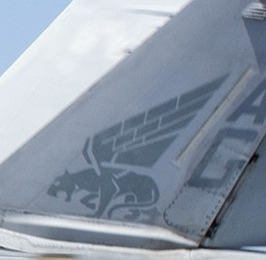
VFA-41 Black Aces

VFA-151 Vigilantes

3 - Air Wing Identifier. This is the two-letter code seen beside the squadron identifier, and like the alphabetic squadron code seen on the spines, these letters also have meaning. They’re used to denote which air wing the aircraft is currently assigned to, which is why if you look at a squadron’s aircraft pictures across a long period of time you’ll note that these letters (and the modex numbers) change.
A/N refer to the fleet, A being Atlantic Fleet and N for the Pacific Fleet. The second code relates to the carrier the air wing is embarked upon.
Using the pictures I’ve posted above as reference, here are some examples:
AC - Air Wing Three, USS Dwight D Eisenhower (Atlantic Fleet) AG - Air Wing Seven, USS George H.W. Bush (Atlantic Fleet) NH - Air Wing Eleven, USS Theodore Roosevelt (Pacific Fleet) NG - Air Wing Nine, USS Abraham Lincoln (Pacific Fleet).
4 - Carrier Assignment. Below the tail in small print is the name of the carrier that squadron (and air wing) is embarked upon. Pretty self explanatory.
5 - NAVY. Branch marking, also self explanatory. Note that USMC aircraft will have MARINES printed there instead.
6 - Serial Number. Located under the rear elevator fin, this six digit number is the aircraft’s unique serial number, which remains unchanged even if the aircraft itself is transferred to another squadron.
I hope I haven’t lost you yet, as I’ve got a few more things to quickly point out.
You may notice in your own research that some aircraft aren’t painted in low-vis markings like the ones I’ve shown here, and that some are fully decorated out. These are typically the “CAG” and “CO” aircraft, painted as such to foster esprit de corps within the squadron and air wing. CAG aircraft (given modex numbers of x00) are the aircraft “reserved” for the Commander of the Air Group (Air wing commander, essentially). Likewise, the “CO” birds are painted in a less-lively livery and given modex numbers of x01, and are reserved for the “Commanding Officer” of the squadron. Here are some examples:
VFA-103 Jolly Rogers CAG Bird

VFA-41 Black Aces CAG Bird
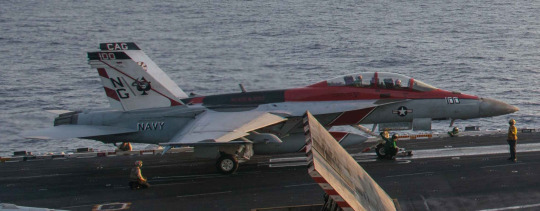
VFA-2 Bounty Hunters CAG Bird

VFA-11 Red Rippers CAG and CO aircraft
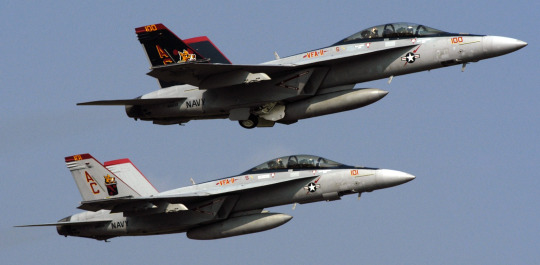
And last thing. Those off-yellow lines that you can see on the nose, vertical tail, and above the NAVY marking? They’re formation markers, and can be activated to glow at different brightness depending on situation requirements. Here’s how it looks at night/low light:

Hope this has helped educate my budding writers and artists! Any questions, don’t hesitate to leave a note, reblog with an @, or send me an ask.
75 notes
·
View notes
Text
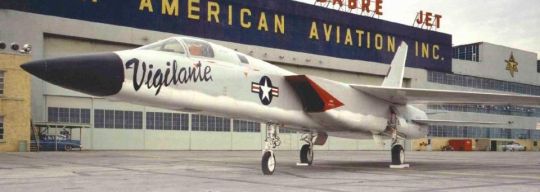
-An XA3J-1 at North American's factory during roll-out. Photo: North American Aviation
FLIGHTLINE: 152 - NORTH AMERICAN AVIATION A-5 VIGILANTE
Designed as a carrier-based supersonic bomber in the 1950s, the Vigilante saw service over Vietnam as a recon plane before being retired in 1979.
Development of what became the A-5 began in 1954 when North American Aviation started a internal program. Seeking to turn around the company's fortunes after the failed XA2J Super Savage, NAA began designing a Mach 2 capable bomber which would give the Navy a nuclear strike option. The initial design, known as the North American General Purpose Attack Weapon (NAGPAW) was evaluated by the US Navy, which replied with a series of needed changes and in July 1955 an initial design contract was awarded, which included a single mockup of the plane. NAA's engineers were able to successfully address the USN's concerns about the design, and in September 1956 a contract for two flying prototypes was signed.

-Orthograph of the A-5 Vigilante. | Illustration: aviastar
DESIGN
The plane, designated XA3J-1, was one of the largest and by far the most complex aircraft to be proposed to operate from a USN aircraft carrier. It had a high-mounted swept wing with a boundary-layer control system (blown flaps) to improve low-speed lift. There were no ailerons, roll control was provided by spoilers in conjunction with differential deflection of the all-moving tail surfaces. Power was provided by two widely spaced General Electric J79 turbojet engines (also used on the Convair B-58 and McDonnell Douglas F-4 Phantom II), fed by variable intake ramps. A single large all-moving vertical stabilizer was paired with the all-moving horizontal stabilizers. In order to save space, the wings, tail and radome were all folding. The XA3J had a crew of two seated in tandem, a pilot and a bombardier-navigator (BN) (reconnaissance/attack navigator (RAN) on later reconnaissance versions), who had some of the most advanced equipment of the time, including an early fly-by-wire system (with electromechanical backup), a primitive HUD system, a multi-mode, radar-equipped inertial navigation system, a TV camera in the nose, and a digital computer to run it all.
In order to make the bomber as streamlined as was possible, it was designed to carry additional fuel tanks and a single B27, B28 or B43 freefall nuclear bomb in internal weapons bay, which would be jettisoned over the target as a single "stores train". Provisions were also made to carry two B43 nukes or Mark 83 or Mark 84 conventional bombs on two external hardpoints, or drop tanks to increase range. Operationally however, these hardpoints were rarely used.
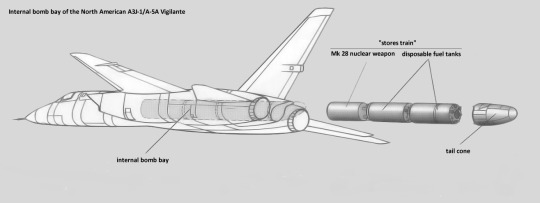
-Internal bomb bay and stores train of the North American A3J-1/A-5A Vigilante. | Illustration: Cobatfor
FLIGHT TESTING, INTRODUCTION, AND SERVICE
First flight of the XA3J was on 31 August 1958 from the same Columbus, OH plant that produced the F-86 and F-100s. Despite one of the prototypes crashing in 1959, the flight tests moved quickly, and by June 1961 the first A3J-1s entered service with Heavy Attack Squadron Three (VAH-3) at NAS Stanford, FL, replacing the Douglas A3D Skywarrior. The following year the plane was redesignated the A-5A under the new tri-service plan. The service life of the A-5A was fraught with issues, with numerous teething problems plaguing its advanced systems. These issues were tamed as maintenance crews became experienced with the Vig's high-tech gadgets, but the plane remained maintenance-intensive (a so-called "hangar-queen") throughout its life. A chronic issue was the stores train bomb release, which had a nasty habit of releasing during catapult shots, resulting in at least one crash. During tests, the train also tended to draft along in the aircraft's slipstream, making accurate bombing (for 1950s/60s definitions of "accurate") difficult.
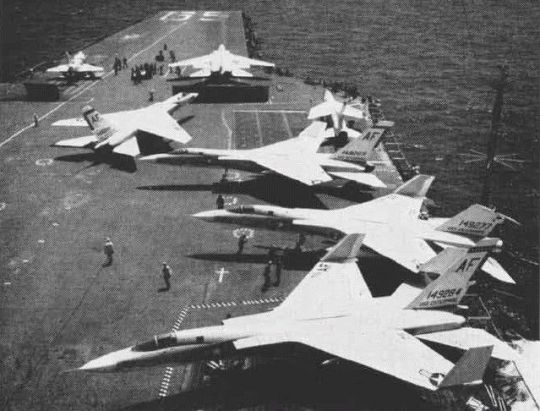
-Five A3J-1 Vigilantes of VAH-7 ("Peacemakers of the Fleet") on CVAN-65 USS Enterprise in 1962. | Photo: USN
Fifty-eight A-5A were completed (out of an order of 64 aircraft) when NAA switched to the upgraded A-5B model. The B model incorporated changes made in light of the Navy's requirement that the Vigilante be able to take off at max weight with zero wind over the carrier being rescinded. This change allowed North American to increase the bomber's weight, adding a dorsal hump to carry more fuel. Only 18 of the A-5B were completed before the US Navy, undergoing a shift in policy away from manned nuclear bombers, canceled the order.
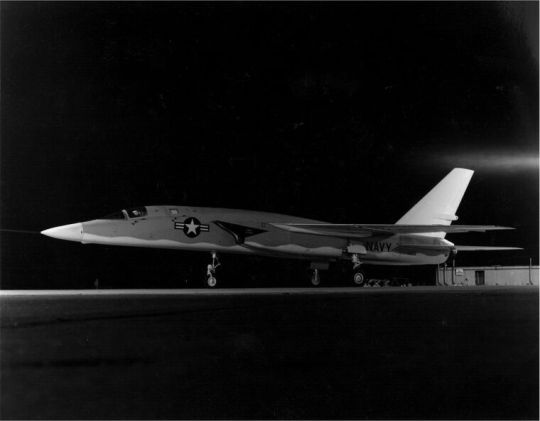
-North American A3J-2 Vigilante (BuNo 146699), circa 1960. This aircraft was the third production A3J-1 which was then modified to an A3J-2 (after 1962 A-5B and YA-5C) and finally to the A3J-3P (RA-5C). | Photo: US Navy
Developed from the A3J-2, the A3J-3P (later RA-5C) was a strike/reconnaissance variant of the Vigilante, incorporating the CCTV in the nose with a "canoe" fairing holding a full suite of gear including:
KA-51A/B forward-looking oblique angle film camera.
KA-50A, KA-51A, or KA-62A vertical film camera.
Passive electronics countermeasures (PECM) antenna for the AN/ALQ-61 Electronic Reconnaissance System. The AN/ALQ-61 was an "electronic intelligence (ELINT)" system that would pick up radar emissions and pin down their coordinates, frequency, and pulse pattern. The ELINT data was recorded on magnetic tape, with storage capacity for 112 minutes of continuous ELINT observations.
Various combinations of panoramic, vertical, or oblique film cameras. Camera fit included KA-58A panoramic camera for medium- to high-altitude work, or a KA-57A panoramic camera for low-altitude work. The cameras shot through prisms in the canoe that could be pivoted to permit shots straight down or from side to side.
AN/AAS-21 infrared sensor, which could provide a continuous film strip of thermal targets, such as hidden trucks, over a field of view 140 degrees wide.
Antenna for the Westinghouse AN/APD-7 "side looking airborne radar (SLAR)" system, which shot radar pulses out to the side of the aircraft and stored the return echo on a long film strip, permitting all-weather, day-night imaging.
Another PECM antenna for the AN/ALQ-21 system.
Additionally, a flash pod, powered by a ram-air turbine in its tail, could be carried under one wing to provide illumination for nighttime recon. The sensors were operated by the back-seater (also known as a "GIB": guy-in-back), formally called a "reconnaissance-attack navigator (RAN)". The bomb bay was filled with semi-permanent fuel tanks (though the plane apparently retained the ability to carry offensive weapons, this was never tested or confirmed). The remaining A-5A and A-5B aircraft were all converted to RA-5C standards, along with 33 new-build aircraft. Squadrons that had formerly flown the A-5 were transitioned to the RA-5 beginning with VAH-3 in July 1963, becoming Reconnaissance Attack Squadrons (RVAH) as they did so. Eventually ten squadrons of RA-5s were established, with the NAS Stanford RVAH-3 being joined by carrier-based RVAH-1, RVAH-5, RVAH-6, RVAH-7, RVAH-9, RVAH-11, RVAH-12, RVAH-13 and RVAH-14.
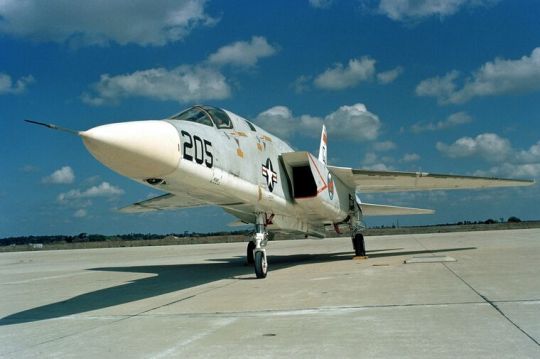
-RA-5C Vigilante of Reconnaissance Heavy Attack Squadron 3 (RVAH-3) "Sea Dragons" is parked on the flight line at Naval Air Station Sanford, Florida, on 27 March 1968. - | Photo: US Navy
Starting in July 1964, the RA-5Cs saw extensive service over Vietnam, carrying out dangerous post-strike damage assessment missions. Although fast and nimble, the Vig proved vulnerable to ground fire, with 14 RA-5s lost to AAA, 3 to SAMs and one shot down by a NVA MiG-21. Nine more were lost to accidents, and as a result three dozen additional aircraft were built between 1968 and 1970. Despite providing invaluable reconnaissance data, the RA-5 began to be phased out starting in 1968, with NAS Stanford being closed and the Vigilante's parent wing, Reconnaissance Attack Wing One, being transferred to Turner AFB in Georgia, which was turned over to the Navy and renamed NAS Albany. Barely six years later, NAS Albany was closed as a result of post-Vietnam drawdowns, and the remaining RA-5s were transferred again to NAS Key West. As newer and larger aircraft like the F-14 and S-3 were introduced in the mid-70s, the Navy began disestablishment of the RA-5 squadrons, with the last leaving Key West on 20 November 1979.
NASA, THE RAAF, AND THE USAF
At least one A3J-1 was bailed to NASA for a time while the Dryden FRC was participating in research for the US SST program. In 1962 Vigilante BuNo 147858 was given NASA tail number 858 and was flown by NASA pilot Bill Dana on 21 flights along airways around LAX to determine approach conditions for an SST landing patterns. After the conclusion of the program, the plane was returned to the Navy.

-NASA's A3J-1, wearing a day-glo orange tail flash, on 19 December 1962. | Photo: NASA DFRC
The RAAF was interested in the A-5 as a possible replacement for their aging Canberra bombers, considering the Vig alongside the F-4, Dassault Mirage IVA, BAC TSR-2 and F-111. Despite the A-5 being available without the delay anticipated for the F-111, the order for three dozen Vigilantes was not issued.
At some point in the Vigilante's development, North American advanced a proposal to the Air Force for the 'Retaliator', an A-5 with a liquid rocket added to the bomb bay, as an interceptor, but the USAF showed no interest. In 1972 NAA again proposed a modified A-5, known internally as the NR-349, to the USAF as an Improved Manned Interceptor. The internal bomb bay was modified to house a third jet, and six AIM-54 Phoenix missiles would be carried under the fuselage. Again the USAF was uninterested.
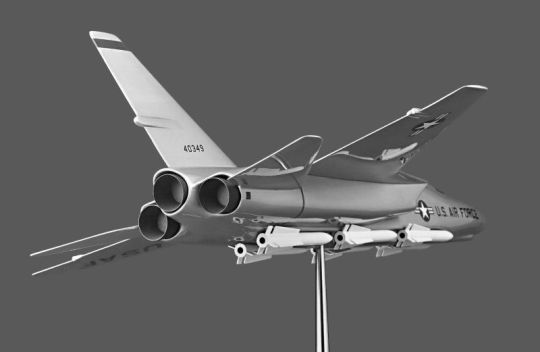
-Scale model of the Improved Manned Interceptor concept, in USAF markings. | Model: NAA/Rockwell
SURVIVORS
By 2004, all of the surviving RA-5s that had been retired to AMARG had been either scrapped or preserved as museum aircraft. A limited number of aircraft were still in storage at NAWS China Lake for eventual use in weapons tests. Around a dozen aircraft have been retained in museums around the US, with only one A-5A on display at NAS Pax River in Maryland, the balance being RA-5s.
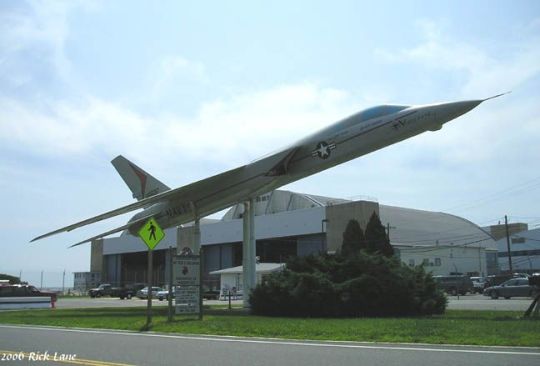
-BuNo 146697, the sole remaining A-5A, on display at Pax River. | Photo: Richard Lane
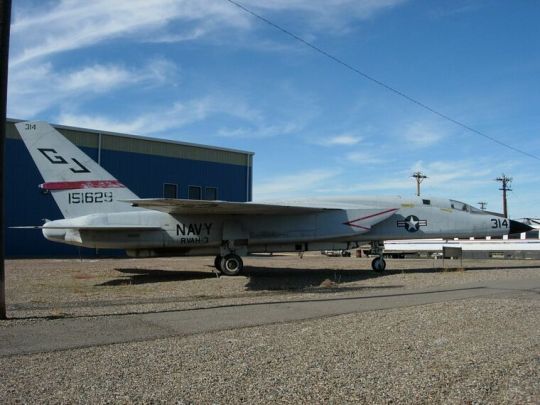
-RA-5C Vigilante (BuNo 151629) on display at the Pueblo Weisbrod Aircraft Museum. It wears the markings of the fleet replacement squadron RVAH-3 Sea Dragons. | Photo: Kristian Jones
#aircraft#aviation#avgeek#airplanes#cold war#airplane#cold war history#coldwar#aviation history#us navy#usn#north american aviation#north american a 5a#a3j-1 Vigilante#a-5a Vigilante#a5a Vigilante#a 5a Vigilante#ra5c Vigilante#ra5c
42 notes
·
View notes
Text
US trials Stinger II gunships in anti-surface warfare role
Gareth Jennings, London - Jane's Defence Weekly
15 March 2020

The US military is trialling the use of the Lockheed Martin AC-130W Stinger II gunship in the anti-surface warfare (ASuW) role in the Middle East.
The Department of Defense (DoD) announced on 15 March that US Navy (USN) Cyclone-class patrol coastal ships (PC) and Boeing P-8A Poseidon maritime multimission aircraft (MMA) assigned to US Naval Forces Central Command (NAVCENT) had conducted "a first-of-its-kind" joint exercise with US Air Force (USAF) AC-130W gunships assigned to Special Operations Command Central (SOCCENT) on 8 and 9 March.
According to the DoD, the exercises were designed to enhance the capabilities of US forces to respond to surface threats and involved P-8 aircraft performing long-range reconnaissance ahead of PCs selecting simulated surface targets for the AC-130W to engage.
"This exercise mark[ed] the first time these assets ha[d] been integrated in direct support of maritime security operations in the Arabian Gulf," the DoD said.
The AC-130W Stinger II (formerly known as Dragon Spear) is a gunship-variant of the C-130 Hercules transport aircraft and is flown by the Air Force Special Operations Command (AFSOC). It is armed with a GAU-23 Bushmaster 30 mm cannon, a 105 mm gun, and stand-off precision-guided munitions such as the Boeing GBU-39 Small Diameter Bomb (SDB) and Raytheon's AGM-176A Griffin missile. AFSOC has 12 such aircraft in its inventory, flying alongside C-130-gunship variants such as the AC-130J Ghostrider.
These joint exercises are in support of the USN's Destroyer Squadron (DESRON) 50/Combined Task Force (CTF) 55, which conducts maritime security operations in support of regional security and stability in the 5th Fleet's area of responsibility (AoR) that encompasses about 6.5 million km 2 across the Gulf, Arabian Sea, Gulf of Oman, Red Sea, and parts of the Indian Ocean.
13 notes
·
View notes
Text
Anglo-Portuguese Alliance, the oldest alliance in the world that is still in force

The Anglo-Portuguese Alliance ratified at the Treaty of Windsor in 1386, between England (succeeded by the United Kingdom) and Portugal, is the oldest alliance in the world that is still in force – with the earliest treaty dating back to the Anglo-Portuguese Treaty of 1373.
Historically, the Kingdom of Portugal and the Kingdom of England, and later the modern Portugal and United Kingdom, have never waged war against each other nor have they participated in wars on opposite sides as independent states since the signing of the Treaty of Windsor. While Portugal was subsumed under the Iberian Union, rebellious Portuguese factions and government in exile sought refuge and help in England. England spearheaded the Anglo-Spanish War (1585–1604) on the side of the deposed Portuguese royal house.
The alliance has served both countries throughout their respective military histories, influencing the participation of the United Kingdom in the Peninsular War, the UK's major land contribution to the Napoleonic Wars and the establishment of an Anglo-American base in Portugal. Portugal aided England (and later the UK) in times of need, for example, in the First World War. Today, Portugal and the United Kingdom are both part of NATO, a larger intergovernmental military alliance between several North American and European states that accounts for over 70% of total global military spending.
The Anglo-Portuguese alliance had in fact been born primarily out of converging strategic interests. An alliance between France and Castile (precursor to the kingdom of Spain) in 1369 had caused consternation at the English court. Fourteenth century Anglo-French relations mostly alternated between hostile rivalry at best to periods of open conflict and war at worst. Through the alliance with Castile, which had one of the largest fleets in Western Europe, France could utilize Castilian sea power, in its struggle against England. Therefore closer union with Castile’s western neighbour Portugal was a logical step to counter this threat. Added to this was a dynastic interest as the Duke of Lancaster, John of Gaunt, had a legitimate claim to the throne of Castile through his wife, Constance, daughter of Peter the Cruel (1334-1369).
However the alliance and Portuguese independence itself was soon under threat of becoming extinct in the early 1380s.
England had already sent a failed expedition to Portugal in 1381-2 under the duke's brother Edmund of Langley in an attempt to push Castile out of the war. It was even detrimental the hitherto close Anglo-Portuguese ties. Undisciplined English troops had caused outrage by raiding Portuguese towns and killing inhabitants whilst exclusion from Portuguese-Castilian peace negotiations in 1382 drew English resentment.
This was shortly followed by a political crisis caused by the death of King Fernando of Portugal on 23rd October 1383. Fernando’s son in law was the Castilian King Juan I who began stripping away Portuguese independence in favour of political and dynastic union with Castile. Portuguese nationalist opposition rallied around King Fernando’s half-brother João of Aviz and resistance quickly escalated into civil war.

João of Aviz was desperate for outside military help and sent ambassadors to England to request permission to recruit soldiers there. The Portuguese ambassador Fernando Afonso de Albuquerque, Master of the Portuguese military order of St James succeeded initially in raising only a modest force of approximately 800 Anglo-Gascon troops. Nevertheless these soldiers would play a laudable role in the eventual defeat and withdrawal Castilian forces from Portugal particularly in their contribution to the victory over Castilian troops at the battle of Aljubarrota (14th August 1385).

Running concurrently with military efforts were diplomatic measures orchestrated by João of Aviz, to ensure that Portuguese independence would survive. Ten days after his coronation on 15th April 1385, he had instructed his ambassadors to negotiate an alliance with Richard II of England and to raise much needed loans to pay his troops.
João I, King of Portugal granting powers to his ambassadors Fernão de Albuquerque, Master of the military order of St. James, and Lourenço João Fogaca, to conclude an alliance with Richard II and John, Duke of Lancaster, and to raise loans in England for payment of the Portuguese troops. Sealed at Coimbra and dated 15 April 1385


On 9th May 1386 the original draft (protocol) of the treaty was produced and ratification of the treaty was enrolled in the 'Treaty Rolls' records in the office of Chancery finally on 1st December 1386


The most important part of the treaty stated that:
“It is cordially agreed that if, in time to come, one of the kings or his heir shall need the support of the other, or his help, and in order to get such assistance applies to his ally in lawful manner, the ally shall be bound to give aid and succour to the other, so far as he is able (without any deceit, fraud, or pretense) to the extent required by the danger to his ally’s realms, lands, domains, and subjects; and he shall be firmly bound by these present alliances to do this.”
In the short term the military objectives of the alliance concerned with neutralizing the Castilian threat to England and indeed Portugal failed. The duke of Lancaster’s expedition was ultimately fruitless and he sued for peace with Juan I of Castile in exchange for a generous pension. With the strategic and dynastic motive for the alliance removed (at least from an English perspective), the alliance with Portugal was temporarily sidelined.
The reason that the alliance did not fizzle out was the marriage of Philippa, daughter of the duke of Lancaster to João I of Portugal in 1387 which added a crucial dynastic element to the alliance between the two kingdoms.

Moreover the two nations were enjoying the commercial benefits that the treaty endorsed. Portuguese government records, for instance, show that the city of Porto was profiting from the trade in cloth and a wealth of other commodities from England passing through its port and gates.
Perhaps the biggest legacy was the successful adherence to terms in the treaty of Windsor that supported mutual military assistance and security. Although not invoked until several centuries later, the terms of the alliance were to be called upon during the eighteenth and nineteenth centuries when Portuguese independence was again threatened. In 1762 Anglo-Portuguese forces successfully defeated a Spanish invasion force and again during the Peninsula war of 1808-1814, Anglo-Portuguese troops under the Duke of Wellington thwarted Napoleon’s attempts to conquer Portugal, most notably at the battle of Bussaco (27th September 1810).

During WWII, Portugal proved that it was still strongly committed to the alliance. In spite of Portuguese neutrality, British ships were allowed to refuel in Portuguese ports and Portuguese planes participated in reconnaissance missions for the Atlantic convoys. Moreover in 1943 Portugal agreed to British and American air force squadrons being stationed in the Lajes, Azores.

It is a testimony to the continued commitment demonstrated by both nations down the centuries to support one another that to this day the Anglo-Portuguese alliance is still a valid agreement endorsed by both countries and no doubt will continue to be in the future.
5 notes
·
View notes
Photo

Executive Officer, Surface Warfare Engineering School Command Great Lakes
Lieutenant Commander Gary L. Hudson
Lt. Cmdr. Gary Hudson, a native of Fort Lauderdale, Florida, enlisted in the U.S. Navy in August 1991and completed yeoman “A” school in Meridian, Mississippi. In April 2008, he was selected for the limited duty officer Program and commissioned as an administrative officer. He holds a bachelor’s degree in business administration and two master’s degrees in human resource management and education from Touro University in New York City. He has completed Navy War College – Joint Professional Military Education Phase I.
His sea duty assignments include Strike Fighter Squadron 213 (VFA-213) “Blacklions” at Naval Air Station, in Miramar, California; USS Abraham Lincoln (CVN 72); Naval Mobile Construction Battalion (NMCB) 5; NMCB 3, as the administrative/legal officer; USS Emory S. Land (AS 39) as the administrative/public affairs officer; and USS Ronald Reagan (CVN 76) as the ship’s administrative officer.
Ashore, Hudson served with Naval Air Station Corpus Christi, Texas, in the Staff Judge Advocate’s office; Commander, Patrol and Reconnaissance Wing 2 in Kaneohe Bay, Hawaii; Navy Region Midwest as flag secretary to the Commander; Strike Fighter Squadron 101 (VFA-101) as the administrative officer; Personnel Support Detachment Bahrain as officer in charge; and as the deputy force personnel readiness & enlisted distribution for Commander, Naval Air Force, U.S. Pacific Fleet, in San Diego.
Hudson reported as executive officer for Surface Warfare Engineering School Command Great Lakes in October 2022.
His personal awards include the Meritorious Service Medal (two awards), Navy and Marine Corps Commendation Medal (six awards), Navy and Marine Corps Achievement Medal (eight awards, one with Combat “V”), Combat Action Ribbon, Presidential Unit Citation, Good Conduct Medal (five awards) and other various personal and unit awards.
Last Updated: 3 November 2022
0 notes
Video
220921-N-IS471-542 by U.S. Pacific Fleet Via Flickr: KADENA AIR BASE, Japan (Sept. 21, 2022) Members of Japan Maritime Self-Defense Force Air Reconnaissance Squadron (VQ) 81 and Fleet Air Reconnaissance Squadron (VQ) 1 pose for a group photo in front of a US Navy EP-3 during Raijin 22-2, an annual unit exchange. Based out of Whidbey Island, Washington, the VQ-1 "World Watchers" are currently operating from Kadena Air Base in Okinawa, Japan. The squadron conducts naval operations as part of a rotational deployment to U.S. 7th Fleet. (U.S. Navy photo by Mass Communication Specialist First Class Glenn Slaughter)
0 notes
Photo

#Repost @deptvetaffairs • • • • • • A native of Memphis, Tennessee, Nora Wingfield Tyson graduated with an English degree from Vanderbilt University in 1979. After graduating, she attended Officer Candidate School before commissioning in December 1979. After finishing her first tour in Washington, D.C., in 1983, Tyson became a naval flight officer. She later served three tours in Fleet Air Reconnaissance Squadron Four (VQ-4) in both Naval Air Station Patuxent River and Tinker Air Force Base. Until 2007, Tyson took on multiple on-shore and off-shore duty assignments. These ranged from serving as a political-military planner and assistant in the Asia-Pacific Division of the Strategic Plans and Policy Directorate for the Joint Chiefs of Staff to undertaking two deployments in the Persian Gulf for Operation Iraqi Freedom. In September 2007, she promoted to rear admiral (lower half) and was the first woman to command the forward deployed Singapore-based Task Force 73. On July 29, 2010, Tyson became the first woman to command a carrier strike group with the nuclear-powered carrier USS George H.W. Bush as its flagship. As the commander of Carrier Strike Group 2, she lead 13 ships, 80 combatant aircrafts and about 9,000 sailors. She lead the strike group in combat operations in support of Operations New Dawn and Enduring Freedom. In August 2011, Tyson promoted to rear admiral (upper half) with former President George H.W. Bush administering the oath to office. In July 2013, she promoted to vice admiral and became deputy commander of the U.S. Fleet Forces Command. In July 2015, Tyson assumed command of the U.S. 3rd Fleet, becoming the first woman to command an operational numbered fleet. Under her command, she oversaw several 3rd Fleet forward deployments, which included two surface action groups and a carrier strike group. When asked about Tyson’s impact on the Navy, Commander of the U.S. Pacific Fleet Adm. Scott Swift said, “The success women in the Navy enjoy today is in large measure because of the barriers she knocked down.” After almost 40 years of service, Tyson retired in September 2017. Thank you for your service! #HonoringVets #Veterans https://www.instagram.com/p/CbnZAfnpN-q/?utm_medium=tumblr
0 notes
Text

USAF receives its second modernized "nuclear crumble" aircraft
The USAF's Boeing WC-135R Constant Phoenix can not only collect weather data, but also use its highly specialized sensors to collect and analyze airborne particles that indicate nuclear contamination.
Fernando Valduga By Fernando Valduga 05/24/23 - 14:00 in Military
The U.S. Air Force (USAF) announced that the second modernized Boeing WC-135R Constant Phoenix was officially stationed at Offutt Air Base, Nebraska, USA.
The WC-135R is a specialized aircraft capable of collecting and analyzing air samples to detect the presence of suspended nuclear material in the air. It is also known informally as "Time Bird" or "Sniffer" by the program team.
A first unit of this highly modified model was delivered in July last year. Offutt Air Base will receive a total of three modernized WC-135Bs, replacing two old aircraft of this type.
Lieutenant Colonel Chris Crouch, commander of the 45º Reconnaissance Squadron, said: "We are very pleased to have a second jet. The 831 expands our capabilities and makes it easier for us to make decisions when it comes to juggling and training operations."

Maintainers receive tail number WC-135R Constant Phoenix 64-14831 for the first time in May 2023, at Offutt Air Base, Nebraska. (Photo: USAF / Nicholas Harnack)
The WC-135R fleet is operated by the 45º Reconnaissance Squadron and the 21º Surveillance Squadron, Det 1. In daily operation, the aircraft collects meteorological data.
"The fact that the 831 is exactly the same as the 836 from nose to tail makes us expect much smoother, more efficient and better operations than we had previously with the two old aircraft," said Lieutenant Colonel Sean Orme, commander of the Det. 1. "I'm very excited."
The WC-135R, registration number 64-14831, is a veteran aircraft. It was delivered to the USAF in 1964 and last flew as a tanker plane with the 161ª Air Refueling Wing of the Arizona National Air Guard. As part of the wide conversion of the 645º Group of Aeronautical Systems, the four-engine jet received a totally new cockpit and was equipped with four modern engines.
The third and final WC-135R is scheduled for delivery in the third quarter of this year.
In January of this year, the first modernized WC-135R aircraft made a flight near the Brazilian coast, well followed on the flight monitoring websites.
Tags: Military AviationUSAF - United States Air Force / U.S. Air ForceWC-135 Constant Phoenix
Fernando Valduga
Fernando Valduga
Aviation photographer and pilot since 1992, has participated in several events and air operations, such as Cruzex, AirVenture, Daytona Airshow and FIDAE. He has works published in specialized aviation magazines in Brazil and abroad. Uses Canon equipment during his photographic work around the world of aviation.
Related news
F-16 fighter of the Polish Air Force. (Photo: Omar Marques/Getty Images)
MILITARY
Training of Ukrainian pilots in the F-16 started in Poland
05/24/23 - 18:37
MILITARY
LIMA: MBDA offers ASRAAM and Brimstone missiles for Malaysian FA-50 aircraft
24/05/2023 - 18:16
MILITARY
South Korean F-35A jet that landed on his belly should be discarded
24/05/2023 - 16:00
MILITARY
Pentagon: No F-16 will be sent to Ukraine for now, only pilot training
05/24/2023 - 08:15
MILITARY
IMAGES: "Retired" F-117 Nighthawk fighters participated in a major USAF exercise in Alaska
23/05/2023 - 22:55
MILITARY
VIDEO: B-2 flies for the first time in months after safety break
23/05/2023 - 19:10
homeMain PageEditorialsINFORMATIONeventsCooperateSpecialitiesadvertiseabout
Cavok Brazil - Digital Tchê Web Creation
Commercial
Executive
Helicopters
HISTORY
Military
Brazilian Air Force
Space
Specialities
Cavok Brazil - Digital Tchê Web Creation
5 notes
·
View notes
Text
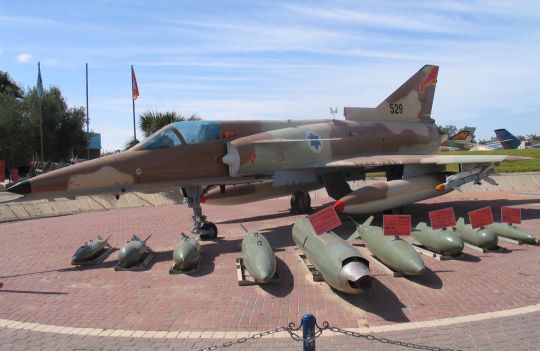
-An Israel Aircraft Industries Kfir C2 at the Muzeyon Heyl ha-Avir (Israeli Air Force Museum), Hatzerim Air Base, Israel, in 2006. | Photo: Bukvoed
FLIGHTLINE: 185 - ISRAELI AIRCRAFT INDUSTRIES KFIR ("LION CUB")
Developed from the IAI Nesher, itself an unlicensed copy of the Dassault Mirage 5, the Kfir served with the IAF as well as several export countries.
In the early 1960 the Israeli Air Force purchased a force of nearly four dozen Dassault Mirage IIIC aircraft, mainly fighter variants, along with a few configured for recon and four two-place trainers. The Mirage was the first Mach-2 aircraft in the IAF, and served throughout the Sixties as the backbone of the force. The Israelis were disappointed in the range of the IIIC however, which reduced the usefulness of the plane in the ground-attack role. Dassault responded by developing the Mirage 5, a fair-weather nuclear-capable version which had a longer range. By the time Dassault completed the IAF's order however, changing political winds in France saw an embargo placed on Israel, and the 50 Mirage Vs ordered wound up in the French Air Force instead.
Undeterred, a copy of the Mirage 5 was produced by Israeli Aircraft Industries as the IAI Nesher using plans and specifications acquired from other Mirage users as well as plans for the 5 acquired by espionage. The Nesher wasn't quite the plane the IAF needed, however, and IAI set about developing a better version. In addition to improving the aerodynamics of the design, a more powerful engine was sought, and two were selected for trials: the GE J79 turbojet and the Rolls-Royce Spey turbofan. Despite the Spey being more powerful, the J79 was chosen and a license agreement signed by Beit Shemesh Engines Ltd. to produce the engine in Israel. The design was altered to accommodate the larger jet, with the aft fuselage shortened and widened, with larger intakes fitted to the front, and an auxiliary intake was added to the tail fin to admit extra air to cool the afterburner. A titanium heatshield was added as well. The prototype, codenamed the Ra'am B ("Thunder B") took it's maiden flight in June 1973. The Ra'am had a redesigned cockpit as well as strengthened landing gear, reconfigured fuel tanks which increased capacity to 713gal total, and small canard foreplanes added above and behind the intakes. The Ra'am B also had a large percentage of domestic avionics.
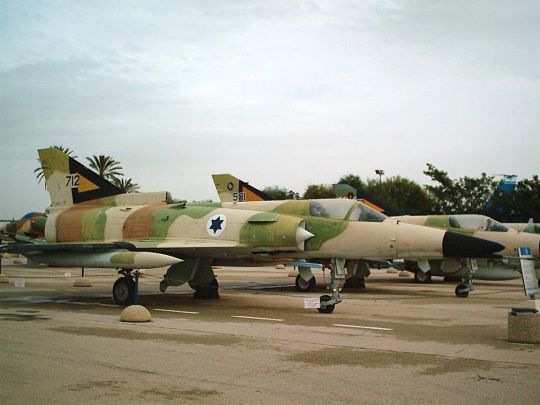
-A Kfir C.1 at the IDF/AF Museum. | Photo: Eranb
The Ra'am B was approved for production and was now called the Kfir ("lion cub") C.1. The Kfir, like the Ra'am B and Mirage 5 before it, had a delta wing with a wingspan of 8.22m, while the aircraft was 15.65m long and 4.55m tall. Empty weight was 7,285kg, while the max TO weight was 16,200kg. The J79-J1E turbojet, which produced 11,900lb thrust (17,900lb with afterburner) pushed the Kfir to a maximum speed of Mach 2.3, a service ceiling of 17,680m, and a combat range of 768km (carrying seven bombs, two missiles and two drop tanks). Armament consisted of two 30mm DEFA cannon with 140 rounds per gun, while stores could be up to 5,775kg of unguided SNEB or Matra JL-100 rocket pods, AIM-9 or locally produced Shafrir or Python AAMs, Shrike anti-radiation missiles, AGM-65 guided missiles, or a variety of unguided or guided bombs, including specialty weapons like the TAL series of cluster bombs and the Matra Durandal anti-runway munition. The Kfir could also be fitted with reconnaissance pods.

-Orthograph of the Kfir. | Illustration: Marcin Zieliński
The first C.1 were delivered to the 101st "First Fighter" Squadron in 1975, and served as the IAF's primary air superiority plane, flying alongside the McDonnnell F-4, which had by then been acquired from the US. The C.1 was swiftly followed by the improved C.2 variant, which had dogtoothed leading edges, small strakes under the nose and more highly swept canards. The C.2 was the first version to see combat, participating in an airstrike against a training camp near Tel Azia, Lebanon on 9 November 1977. Two years later, another C.2 gained the Kfir's only air-to-air kill, shooting down a Syrian MiG-21. During the 1982 Israeli invasion of Lebanon the Kfirs had ceded the air superiority role to the F-15 and F-16, and so they were mainly used for strike missions, often flying unescorted. Beginning the following year, the Kfir C.2 were updated to C.7 standards, which included an uprated J79 engine, two additional pylons under the wings, a new Elta El/M-2021B radar, an updated cockpit featuring hands-on-throttle-and-stick (HOTAS) controls, an inflight refueling probe and larger canards. A trainer version, the two-seat TC.7, was also developed. Despite the Kfir's abilities, the availability of the superior F-15I Ra'am and F-16I Sufa led to the type's retirement in the mid-1990s.
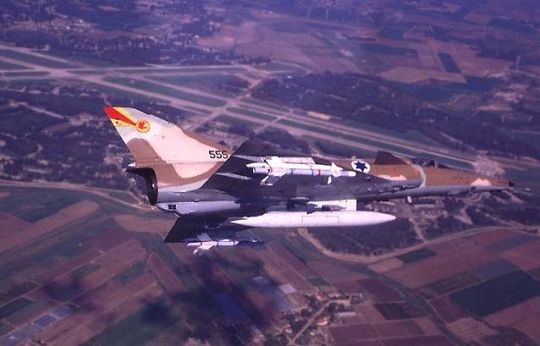
-An Israeli C.7 in flight. | Photo: Israeli Air Force
FOREIGN SERVICE
Despite being manufactured in Israel (under license), the Kfir's use of the J79 means that sales of the fighter are subject to approval by the US State Department. Despite this, the Kfir has been exported to several countries. The first client was Ecuador, which purchased twelve ex-IAF Kfir, ten C.2 and two TC.2 trainers, in 1981, which were delivered to the FAE in 1982-83. The Kfir saw action in the 1995 conflict between Ecuador and Peru, where they acted as escorts for the Ecuadorian A-37s. On 10 February 1995, an Ecuadorian C.2 shot down a Peruvian A-37, scoring the FAE's only kill with the type to date. In 1996 three more C.2 and a third TC.2 were acquired. A third purchase of eight of the newly developed C.10 model was blocked by the US, but a second option to purchase two C.10 and upgrade some or all of the existing fleet of C.2 to the same standard was approved. The C.10 is broadly similar to the C.7 in capacity, but is tailored for export, and has both helmet-mounted display and two multi-function displays in the cockpit. The C.10, also known as the CE by the FAE, also has the ability to fire upgraded Python 3 and 4 IR missiles. As of 2005, four of Ecuador's Kfir are known to have been lost in accidents, three fighters and one of the TC.2s.

-Three FAE aircraft, a C.2, Mirage F.1 and Jaguar (l-r), during the BLUE HORIZON exercise in 1986. | Photo: USAF
The US Navy and USMC leased a force of 25 C.1 between 1985 and 1989, these aircraft were officially designated the F-21A Lion and were used by Navy Fighter Squadron 43 (VF-43) at NAS Oceana, Virginia and Marine Fighter Training Squadron 401 (VMFT-40) at MCAS Yuma, Arizona for dissimilar air combat training. The F-21A were painted in schemes commonly worn by Warsaw Pact aircraft, specifically the MiG-23, which was then seeing widescale introduction, and whos performance the Kfir/Lion largely matched. The USN and USMC Lions were modified with the addition of narrow-chord canards and two strakes on either side of their noses, both of which improved low-speed maneuverability and handling. The US Navy F-21A were returned to Israel in 1988 and were replaced by the F-16N, while the USMC F-21 were returned in 1989 and were replaced by F-5E Tiger IIs, although these were not as capable as the Lions.

-One of VF-43's F-21A in flight over the desert in 1985. | Photo: US Navy
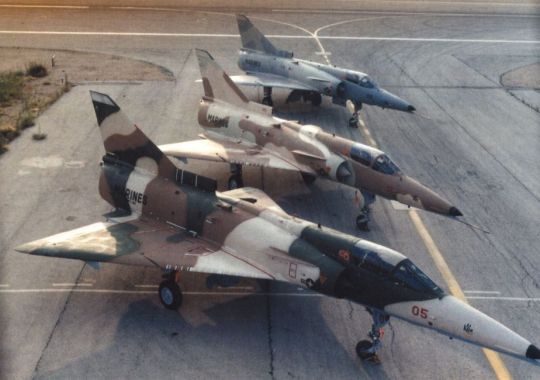
-Three Marine F-21 of VMFT-401, showing the variety of paint schemes worn during DACT. | Photo: USMC
In addition to the USN/USMC F-21s, six ex-IAF Kfir were purchased by Airborne Tactical Advantage Company of Newport News, VA to serve as aggressor aircraft in training by US Navy, USAF and Air National Guard units. ATAC also flies Mirage F.1s, Hawker Hunters, A-4 Skyhawks and L-39 Albatroses. One of ATAC's Kfir crashed at NAS Fallon on 6 March 2012, killing the pilot.
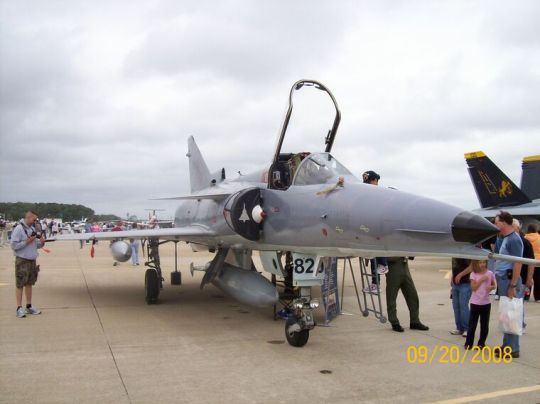
-An ATAC Kfir at the NAS Oceana air show in 2008. This aircraft, registration N404AX, crashed in 2012. | Photo: Justin Gibb
The Colombian Air Force (FAC) acquired 12 ex-IAF Kfir C.2 and one TC.2 in 1989, which were upgraded to C.7 standards and which saw use in counter-insurgency missions in the late 80's and 90's. A deal for twenty-four more aircraft was signed in 2008. These ex-IAF C.7 were upgraded to C.10 or C.12 standards (the C.12 is largely similar to the C.10, but lack radar) before deliveries began in 2009. FAC's existing C.2s were also upgraded under the same deal. On 1 November 2013 two Russian Air Force Tu-160 Blackjack bombers took off from Simon Bolivar Airport in Venezuela and crossed into Colombian air space, where they were intercepted and escorted out by FAC Kfirs. In 2017 FAC's C.10s were upgraded to EL/M 2052 AESA radar, which allows the planes to fire the I-Derby-ER, an extended range variant of its Derby FAF (fire-and-forget) active-radar missile as well as the advanced Python-5 beyond-visual-range (BVR) IR missile. As of 2019 23 of FAC's Kfir remain in service.
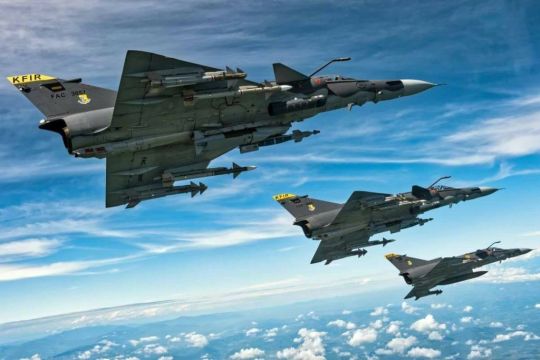
-Three FAC Kfir in flight. The aircraft are carrying a mixed load of Python and Derby missiles as well as a LGB and desginator as well as a drop-tank. | Photo: FAC
Between 1995 and 2005 the Sri Lankan Air Force acquired ten C.2, one TC.2 and four C.7, all ex-IAF aircraft. The SLAF Kfir saw action against LTTE rebels during the long-running Sri Lankan civil war, during which time two C.7 were destroyed by rebels on the ground in 2001, and three more to training accidents. In 2011, two Kfir collided in midair during a practice session for an airshow. In June 2021 the SLAF finalized a contract to upgrade five of their Kfir and return them to service.
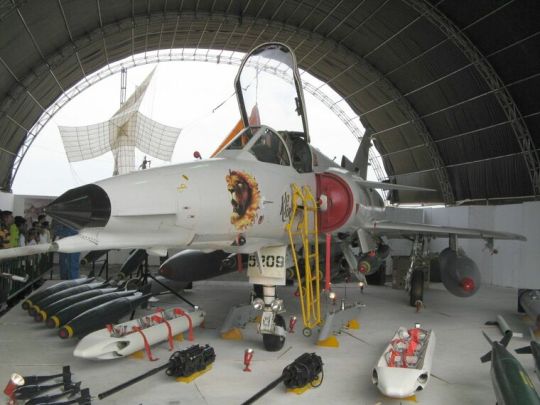
-A Kfir C.2 of the No.10 Squadron on display during an airshow/open house in 2011. | Photo: Chamal Pathirana
NO LONGER "CUBS"
Even today, IAI continues to develop and offer upgrades of the Kfir. The Block 60 are existing aircraft which have undergone extensive refurbishment, essentially returning them to zero airframe and powerplant hours. The Block 60 also incorporate the EL/M-2032 AESA radar, which gives look-down/shoot-down capability as well as tracking of up to 64 targets. Finally, Block 60 aircraft feature an open-source architecture, allowing clients to tailor the avionics to their needs and sources. Colombia has expressed interest in upgrading their aircraft, and other Block 60s have been offered to Bulgaria and Argentina.
Colombia, Ecuador and Sri Lanka have also been offered the Kfir NG (Next Generation), which can be either refitted older Kfir or new-build aircraft, powered by a GE-414 which is lighter, smaller and more fuel-efficient but more powerful than the J79 it replaces, allowing the Kfir NG to carry an additional kiloliter of fuel. The wing is also upgraded with new slats and fly-by-wire technology. Upgrades to the radar include the same EL/M-2052 AESA as the C.10, as well as the open system architecture and cockpit of the C.10 and Block 60.
#aircraft#aviation#avgeek#airplanes#airplane#cold war#cold war history#coldwar#aviation history#usaf#iaf#idf#israeli air force#israeli defense forces#israel#iai#dassault#Ecuador#colombia#sri lanka#peru
13 notes
·
View notes
Photo

One Of The U.S.Navy's Nuclear Command-And-Control Aircraft Was Damaged In Hangar Incident http://bit.ly/2SO9Po6
Sailors with the Navy’s VQ-4 Fleet Air Reconnaissance Squadron at Tinker Air Force Base, Oklahoma, make preparations for moving an E-6B Mercury out of a TACAMO hangar bay in 2013. (Air Force photo by Mike W. Ray)
Defense Tech: One of Navy's Nuclear War Contingency Aircraft Damaged in Hangar Incident A Navy plane was being towed out of a hangar last week when its tail clipped the top of the structure, leading to what could amount to millions of dollars in repairs. An E-6B Mercury, a nuclear command-and-control aircraft, was being moved at Tinker Air Force Base, Oklahoma, on Thursday as part of its daily operations when the vertical stabilizer at the rear of the aircraft struck the hangar, said Lt. Travis Callaghan, a spokesman for Naval Air Forces. The incident has been labeled a Class-A mishap by the Naval Safety Center, meaning the damages to the aircraft likely total at least $2 million. Read more .... WNU Editor: Ooops! from War News Updates http://bit.ly/2BAcEPR via IFTTT
0 notes
Text
JF-17 Thunder
The PAC JF-17 Thunder is a lightweight, single-engine, multi-role combat aircraft developed jointly by the Pakistan Aeronautical Complex (PAC) and theChengdu Aircraft Corporation (CAC) of China. The JF-17 can be used for aerial reconnaissance, ground attack and aircraft interception. Its designation "JF-17" by Pakistan is short for "Joint Fighter-17", while the designation and name "FC-1 Xiaolong" by China means "Fighter China-1 Fierce Dragon".
The JF-17 can deploy diverse ordnance, including air-to-air and air-to-surface missiles, and a 23 mm GSh-23-2 twin-barrelautocannon. Powered by a RD-93 afterburning turbofan it has a top speed of Mach 1.6. The JF-17 is to become the backbone of the Pakistan Air Force (PAF), complementing the General Dynamics F-16 Fighting Falcon. The PAF inducted its first JF-17 squadron in February 2010 and four years later 49 units were in service (one lost in a crash), and 110 units were on order.
Background
The JF-17 was primarily developed to meet the PAF's requirement for an affordable, modern, multi-role combat aircraft as a replacement for its large fleet of Dassault Mirage III/5 fighters, Nanchang A-5 bombers, and Chengdu F-7 interceptors, with a cost of US$500 million, divided equally between China and Pakistan. The aircraft was also intended to have export potential as a cost-effective and competitive alternative to more expensive Western fighters.
By 1989, because of economic sanctions by the US, Pakistan had abandoned Project Sabre II, a design study involving US aircraft manufacturer Grumman and China, and had decided to redesign and upgrade the Chengdu F-7.[6] In the same year, China and Grumman started a new design study to develop the Super 7, another redesigned Chengdu F-7.[7] Grumman left the project when sanctions were placed on China following the political fallout from the 1989 Tiananmen Square protests. After Grumman left the Chengdu Super 7 project, the Fighter China project was launched in 1991.[8] In 1995, Pakistan and China signed a memorandum of understanding (MoU) for joint design and development of a new fighter, and over the next few years worked out the project details.[9] In June 1995, Mikoyan had joined the project to provide "design support", this also involved the secondment of several engineers by CAC.
Production
On 2 March 2007, the first consignment of two small-batch-production (SBP) aircraft arrived in a dismantled state in Pakistan. They flew for the first time on 10 March 2007 and took part in a public aerial demonstration during a Pakistan Day parade on 23 March 2007. The PAF intended to induct 200 JF-17 by 2015 to replace all its Chengdu F-7, Nanchang A-5, and Dassault Mirage III/5 aircraft. In preparation for the in-flight refuelling of JF-17s, the PAF has upgraded several Mirage IIIs with IFR probes for training purposes. A dual-seat, combat-capable trainer was originally scheduled to begin flight testing in 2006; in 2009 Pakistan reportedly decided to develop the training model into a specialised attack variant.
In November 2007, the PAF and PAC conducted flight evaluations of aircraft fitted with a variant of the NRIET KLJ-10 radar developed by China's Nanjing Research Institute for Electronic Technology (NRIET), and the LETRI SD-10 active radar homing AAM. In 2005, PAC began manufacturing JF-17 components; production of sub-assemblies commenced on 22 January 2008. The PAF was to receive a further six pre-production aircraft in 2005, for a total of 8 out of an initial production run of 16 aircraft. Initial operating capability was to be achieved by the end of 2008. Final assembly of the JF-17 in Pakistan began on 30 June 2009; PAC expected to complete production of four to six aircraft that year. They planned to produce twelve aircraft in 2010 and fifteen to sixteen aircraft per year from 2011; this could increase to twenty-five aircraft per year.
Russia signed an agreement in August 2007 for reexport of 150 RD-93 engines from China to Pakistan for the JF-17. In 2008, the PAF was reportedly not fully satisfied with the RD-93 engine and that it would only power the first 50 aircraft; it was alleged that arrangements for a new engine, reportedly the Snecma M53-P2, may have been made. Mikhail Pogosyan, head of the MiG and Sukhoi design bureaus, recommended the Russian defence export agency Rosoboronexport block RD-92 engine sales to China to prevent export competition from the JF-17 against the MiG-29. At the 2010 Farnborough Airshow, the JF-17 was displayed internationally for the first time; aerial displays at the show were intended but were cancelled due to a late attendance decision as well as license and insurance costs. According to a Rosoboronexport official at the Airshow China 2010, held on November 16–21, 2005 in Zhuhai, China, Russia and China had signed a contract worth $238 million for 100 RD-93 engines with options for another 400 engines developed for the FC-1.
#Xi Jinping#President of the People's Republic of China#Pakistan#Fighter aircraft#China#CAC/PAC JF-17 Thunder#Beijing#Airspace#Air chief marshal
0 notes
